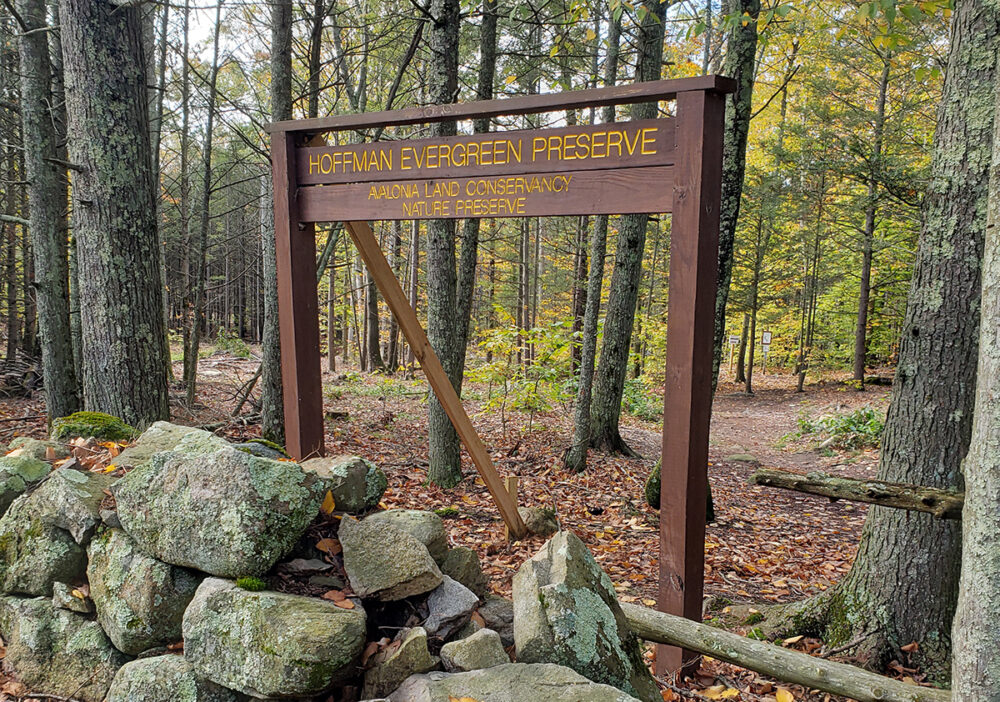
Creating the forest of the future at Hoffman Evergreen Preserve
More than 50 years ago, Robert D. Hoffman planted a forest of hemlock, spruce, and pine trees at what is known as the Hoffman Evergreen Preserve, seeking to recreate the Canadian forest of his youth. Donated to Avalonia, it has been a favorite spot of many who came regularly to enjoy the solitude and beauty of the trails.
However, by 2016, Avalonia came to the conclusion that the Hoffman Evergreen Preserve was struggling due to changing conditions, overcrowding, pests, and disease. As a result, the preserve had virtually no understory, limited birds and pollinators, and largely unhealthy trees. To relieve pressure on the forest and allow new growth to begin, Avalonia sought advice from many expert sources: NRCS, DEEP and especially Audubon CT. A plan was developed and Avalonia brought in a well respected forestry company that completed some limited patch cuts and thinned some of the trees in the fall of 2019. Almost immediately we saw the positive results of letting in the sunlight and by the spring of 2020 native plants like low bush blueberries and wildflowers and grasses began springing up, attracting an abundance of insects, pollinators and birds, some of which had never been seen at Hoffman before.
Beth Sullivan, the chair of the Stonington Town Committee saw an opportunity to learn from this venture, and created a partnership with Dr. Julianna Barrett of UCONN and CT Sea Grant, to request funding from the National Fish and Wildlife Foundation. The primary goal was to enhance restoration of the forest by planning well-researched species that would adapt to the changing climate. At the same time, the team recognized the need for greater education and study in this new area of forestry research to create healthier, climate-resilient forests throughout New. England.
Within Avalonia, Beth recruited Dr. Sharon Lynch, a Stonington Town Committee member and professor at Georgetown University. Sharon created and implemented a four-part webinar series in the spring of 2021 that featured experts on climate change, forests, and adaptive tree strategies. In addition, Sharon developed an educational series in the fall of 2021 that allowed teams of people to learn more about how they could implement that information on the land that they manage.
The Long Island Futures Fund grant was awarded UConn/Sea Grant to implement a cutting-edge research project on climate-resilient forests. Throughout 2020 and 2021, with restrictions imposed by Covid, Beth and Juliana worked together, using nationally known resources, to research tree species that would not only thrive at Hoffman and create a diverse habitat, but that would also be able to withstand hotter, drier temperatures. Understanding that climate disruption is inevitable, they opted to plant trees that are native to New England, but currently growing in warmer climates. For example, teams of volunteers planted dozens of red oaks that originated in Maryland. The red oak is native to New England, but this particular variety is genotyped for hotter, drier weather, so Dr. Barrett surmised that those trees would do well here as temperature rise, while also offering the same benefits to our native ecosystem. Also planted were species that are found in planting zones just south of here: from New Jersey to Virginia that will continue to support wildlife that will also have to adapt to changing climate conditions.
Since May 2021, Beth, Juliana, and dozens of volunteers, of all ages, have planted hundreds of trees of many varieties, as well as shrubs and wildflowers. Informational signage is being installed to educate and encourage Citizen Scientists to monitor changes over time. The result is a preserve that is springing back to life, filling with wildlife, and providing hope that we will be able to help our forests adapt to climate change.
